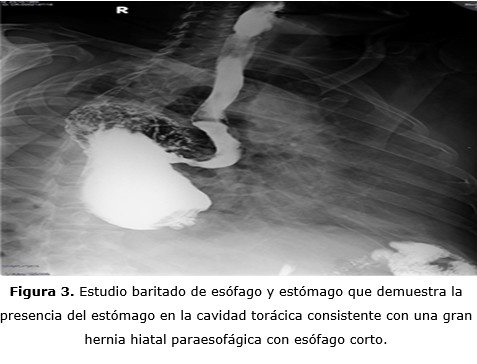Hernia hiatal tipo IV: presentación de caso
Abstract
Fundamento: la hernia hiatal es la anormalidad más frecuente del tracto digestivo superior, se clasifica en cuatro tipos, estas hernias pueden ser por deslizamiento y paraesofágicas, estas últimas de presentación mucho menos frecuente en la práctica clínica como es el caso que se presentó tipo IV; la mayoría son asintomáticas son descubiertas incidentalmente en radiografías de tórax o en tomografía computarizada multicorte y cuando son sintomáticas muchas veces están asociadas a complicación.
Objetivo: presentar un paciente con hernia hiatal tipo IV diagnosticada por tomografía computarizada multicorte.
Presentación del caso: paciente masculino, de 58 años de edad, con antecedentes de hipertensión arterial, que refiere presentar una hernia diafragmática diagnosticada hace 15 años, que presenta dolor abdominal a tipo cólico de moderada intensidad acompañado de distensión abdominal eructos, vómitos y disnea. Al examen físico, abdomen globuloso que sigue los movimientos respiratorios, doloroso a la palpación superficial y profunda. En el tórax se auscultan ruidos hidroaéreos en el lado derecho. La tomografía computarizada multicorte demuestra la herniación de estómago, colon transverso y epiplón en hemitórax derecho a través del hiato esofágico.
Conclusiones: las hernias hiatales son las anomalías más frecuentes del tracto digestivo superior pero las gigantes tipo IV con herniación de otras estructuras abdominales, como colon, omento, intestino delgado, hígado y páncreas son una forma infrecuente de presentación de las mismas. La tomografía computarizada multicorte y el estudio baritado de esófago-estómago-duodeno, resultan fundamentales para el diagnóstico y caracterización de estas lesiones.
DeCS: HERNIA HIATAL/clasificación; HERNIA HIATAL/diagnóstico por imagen; ENEMA OPACO/métodos; TOMOGRAFÍA COMPUTARIZADA MULTIDETECTOR; INFORMES DE CASOS.
Downloads
References
1. Villarreal R, Bernal F, Cabrera LF, Sánchez Ussa S, Pedraza M. Hernia hiatal mixta con vólvulo gástrico intratorácico: reporte de caso y revisión de la literatura. Rev Hispanoam Hernia. 2018;6(4):186-190.
2. Marinos CM, Moris D, Yettimis E, Varsamidakis N. Type IV paraesophageal hernia as a cause of ileus: Report of a case. Int J Surg Case Rep. 2015;6:43–45.
3. Madriz W, Víctor Alvarado VH, Jaén J. Diagnóstico radiológico de hernia hiatal (Revisión bibliográfica y presentación de casos). Rev Med Cos Cen. 2008;65(583):103-108.
4. Yu HX, Han CS, Xue JR, Han ZF, Xin H. Esophagealhiatal hernia: risk, diagnosis and management. Expert Rev Gastroenterol Hepatol. 2018;12(4):319-329.
5. Pérez JJ, Viscarra JF, Ríos CG. Hernia hiatal: un desafío diagnóstico y terapéutico. A propósito de un caso. MÉD UIS. 2017;30(2):83-8.
6. Bermúdez M. Gran hernia paraesofágica con estómago intratorácico total. Informe de un caso y revisión de la literatura. Rev Col Gastroenterol. 2006;21(1):64-69.
7. Mora-Guzmán I, del-Pozo-Jiménez JA, Martín-Pérez E. A giant hiatal hernia and intrathoracic pancreas. Rev Esp Enferm Dig. 2017;109(6):458-459.
8. Banimostafavi ES, Tayebi M. Large hiatal hernia with pancreatic body herniation: Case-report. Ann Med Surg. 2018;28:20–22.
9. Farhat A, Towle D. Incidental Hiatal Hernia on Chest X-ray. JETem. 2018;3(3):29-30.
10. Weitzendorfer M, Köhler G, Antoniou SA, Pallwein Prettner L, Manzenreiter L, Schredl P, et al. Preoperative diagnosis of hiatal hernia: barium swallow X ray, high-resolution manometry, or endoscopy? Eur Surg. 2017;49:210–217.

Published
How to Cite
Issue
Section
License
Copyright: Camagüey Medical Archive Magazine, offers immediately after being indexed in the SciELO Project; Open access to the full text of the articles under the principle of making available and free the research to promote the exchange of global knowledge and contribute to a greater extension, publication, evaluation and extensive use of the articles that can be used without purpose As long as reference is made to the primary source.
Conflicts of interest: authors must declare in a mandatory manner the presence or not of conflicts of interest in relation to the investigation presented.
(Download Statement of potential conflicts of interest)
The Revista Archivo Médico de Camagüey is under a License Creative Commons Attribution-Noncommercial-No Derivative Works 4.0 International (CC BY 4.0).
This license allows others to distribute, to mix, to adjust and to build from its work, even for commercial purposes, as long as it is recognized the authorship of the original creation. This is the most helpful license offered. Recommended for maximum dissemination and use of licensed materials. The full license can be found at: https://creativecommons.org/licenses/












 22 julio 2025
22 julio 2025